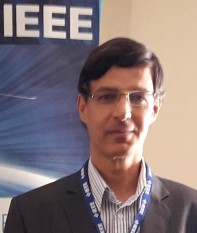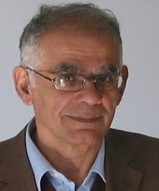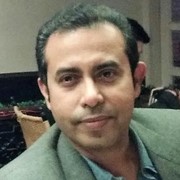Speakers
IEEE Fellow
Royal Military College of Canada, Canada
Talk 1: New Directions for Future Antenna Research
Talk 2: Dielectric and Wireless Antennas
Talk 3: Space and Satellite Antennas
Biography: Dr. Yahia Antar obtained degrees from the University of Alexandria (BSC) and the University of Manitoba (MSc., PhD). He worked at CRC and NRC in Ottawa before joining the Royal Military College of Canada in Kingston where he has held the position of professor since 1990.Dr. Antar is a Fellow of the IEEE and a Fellow of the Engineering Institute of Canada (FEIC). He serves as an Associate Editor of the IEEE Antennas and Propagation Magazine and served as Associate Editor of the IEEE Transactions on Antennas and Propagation, IEEE AWPL. He served on NSERC grants selection and strategic grants committees, Ontario Early Research Awards (ERA) panels, and on review panels for the National Science Foundation. In May 2002, Dr. Antar was awarded a Tier 1 Canada Research Chair in Electromagnetic Engineering which was renewed in 2009. He served on the URSI Board as Vice President, and on the IEEE Antennas and Propagation Society Administration Committee. On 31 January 2011, Dr. Antar was appointed Member of the Canadian Defense Science Advisory Board (DSAB). In October 2012, he received from the Governor General of Canada, the Queen’s Diamond Jubilee Medal in recognition for his contribution to Canada.
IEEE Fellow, IEEE Antenna and Propagation Society President
Concordia University, Canada
Talk: Antenna Challenges for 5G Applications
Biography: Dr. Ahmed Kishk is a Professor and Canada Research Chair Tier 1 at Concordia University, Montreal, Canada. He is also Professor Emeritus, University of Mississippi, USA. He received his BS degree in Electronic and Communication Engineering, Cairo University, Cairo, Egypt, in 1977, and in Applied Mathematics, Ain-Shams University, Cairo, Egypt, in 1980. He obtained his M.Eng and PhD degrees in Electrical Engineering from University of Manitoba, Canada, in 1983 and 1986, respectively. Dr. Kishk is a Fellow of the IEEE and the current President of the IEEE Antennas and Propagation Society. He was an Associate Editor of Antennas & Propagation Magazine from 1990 to 1993. He is now an Editor of Antennas & Propagation Magazine. He was also an editor of the ACES Journal during 1997. He was an Editor-in-Chief of the ACES Journal from 1998 to 2001. He was the chair of Physics and Engineering division of the Mississippi Academy of Science (2001-2002). He was a guest Editor of the special issue on artificial magnetic conductors, soft/hard surfaces, and other complex surfaces, on the IEEE Transactions on Antennas and Propagation, January 2005. He was a technical program committee member in several international conferences. Published over 220-refereed Journal articles and 380 conference papers. He is a coauthor of four books and several book chapters and editor of one book.
Technical University, Prague, Czech Republic
Talk 1: Semi-Active 866 MHz RFID Implantable Tag Fed by 6.78 MHz Inductive Wireless Power Transfer
Abstract: The lecture presents a compact battery-less semi-active UHF RFID tag powered by an inductive wireless power transfer designed to be implanted into the human body. Communication runs at frequency of 866 MHz whereas powering is performed at frequency of 6.78 MHz to reduce losses. Tag sensitivity for communication was increased by about 21 dB with the help of inductive wireless powering when compared to a tag which did not employ this powering. Communication and powering circuits were integrated within compact structures on the sides of the reader and the tag. The reader side consists of a center-excised Archimedes spiral antenna for communication and a circular loop for powering. The tag side consists of a folded dipole antenna for communication and a rectangular loop for powering.
Talk 2: Frequency-Domain Chipless RFID Transponders
Abstract: The lecture presents the summary of our investigations in several topics of frequency-domain chipless RFID transponders. The performance comparison of various types of scatterers used in the literature and recently proposed by the authors is presented. The issue of proper location of adjacent resonant elements in the scatterer array to reduce the mutual coupling and consequently ensure the robust RCS response for reliable fading of coded information is addressed. Advantages and drawbacks of the proposed solutions are discussed and several open challenges in the field are emphasized.
Biography: Dr. Jan Machac is a professor at the Department of Electromagnetic Field, Faculty of Electrical Engineering, Czech Technical University in Prague, Czech Republic. His main scientific interests are: investigation of planar passive elements and subsystems of microwave technology, planar antennas, planar microwave filters, propagation of electromagnetic waves in periodic structures, and artificial electromagnetic materials – metamaterials. He is active in the field of RFID chipless systems, and power wireless transport. Prof. Machac is an author or co-author of more than 250 publications in scientific journals and scientific international and national conferences. In these fields of his scientific interests he has been a principal contractor of a number of scientific projects.
He is a Senior Member of IEEE Microwave Theory and Technique Society, member of the IEEE MTT-S Int. Microwave Symposium Technical Program Review Committee, since 2008, member of the Technical Program Committee of the European Microwave Conference during 1995-1997, and since 2013, a reviewer of: IEEE Transactions on MTT, IEEE MWCL, Electronics Letters, and IET Microwave Antennas & Propagation.
Jan Machac is member of IEEE MTT Society Membership and Geographic Activities Committee and works at Region 8 Coordinator. He works as vice chair of the Technical Committee MTT-15 Microwave Field Theory.
King Abdullah University of Science and Technology, Saudi Arabia
Talk: Flexible, Wearable and Disposable Wireless Sensing Systems Through Additive Manufacturing
Abstract: With the advent of wearable sensors and internet of things (IoT), there is a new focus on electronics which can be bentso that they can beworn or mounted on non-planar objects. Moreover, there is a requirement that these electronics become extremely low cost, to the extent that they become disposable. The flexible and low-cost aspects can be addressed by adapting additive manufacturing technologies such as inkjet, screen and 3D printing. This talk introduces additive manufacturing (with a special focus on inkjet printing) as an emerging new technique to realize low cost, flexible and wearable wireless sensing systems. The ability of inkjet printing to realize electronics on unconventional mediums such as plastics, papers, and textiles has opened up a plethora of new applications. In this talk, various innovative antenna and sensor designs will be shown which have been realized through inkjet or 3D printing methods. Many innovative inks and multilayer processes will be presented where dielectrics are also printed in addition to the metallic parts, thus demonstrating fully printed devices. In the end, many system level examples will be shown for applications such as health care or environmental monitoring through these wireless sensing nodes. The promising results of these designs indicate that the day when electronics can be printed like newspapers and magazines through roll-to-roll and reel-to-reel printing is not far away.
Biography: Dr. Atif Shamim received his M.A.Sc. and Ph.D degrees in electrical engineering at Carleton University, Canada in 2004 and 2009 respectively. He was an NSERC Alexander Graham Bell Graduate scholar at Carleton University from 2007 till 2009 and an NSERC postdoctoral Fellow in 2009-2010 at Royal Military College Canada and KAUST. In August 2010, he joined the Electrical Engineering Program at KAUST, where he is currently an Associate Professor and principal investigator of IMPACT Lab. He was an invited researcher at the VTT Micro-modules Research Center (Oulu, Finland) in 2006. Dr. Shamim was the recipient of the best paper prize at the European Microwave Association Conference in 2008. He was given the Ottawa Centre of Research Innovation (OCRI) Researcher of the Year 2008 Awardin Canada. His work on Wireless Dosimeter won the ITAC SMC Award at Canadian Microelectronics Corporation TEXPO in 2007. Prof. Shamim’s students won the Best Paper Prize (3rd position) in IEEE IMS 2016 and (1st position) in IEEE MECAP 2016. Prof. Shamim also won numerous business-related awards, including the 1st prize in Canada’s national business plan competition and was selected for OCRI Entrepreneur of the year award in 2010. He is an author/co-author of over 150 international publications and an inventor on 18 patents. His research interests are in innovative antenna designs and their integration strategies with circuits and sensors for flexible and wearable wireless sensing systems through a combination of CMOS and additive manufacturing technologies. Dr. Shamim is a Senior Member of IEEE and serves on the editorial board of IEEE Transactions on Antennas and Propagation.
Radiophysics and Electronics-University of Calcutta, India
Royal Military College of Canada, Canada
Talk 1: Multi-Functional Antennas
Talk 2: IEEE Special Interest Group on Humanitarian Technology (SIGHT): Activities by AP Society
Biography: Dr. Jawad Y. Siddiqui is an Associate Professor in the Institute of Radio Physics and Electronics, University of Calcutta, India. He received his Master of Technology and Doctor of Philosophy degrees in RadioPhysics and Electronics from University of Calcutta in 2000 and 2005, respectively. He worked as a visiting researcher at the Royal Military College of Canada, at different periods during 2008-2014. He has more than 100 publications in peer reviewed journals and conferences. His research areas include ultra-wideband antennas, ultra-wideband radar, frequency reconfigurable antennas, and multi-functional antennas. He is a Co-Principal Investigator on Stratosphere Troposphere (ST) Radar Project at the University of Calcutta. He is a Senior Member of the IEEE and served as Chair for the AP-S/MTT-S Jt. Chapter, IEEE Kolkata Section in 2015. He is currently the Chair, SIGHT Chapter, IEEE Kolkata Section. He is a member of the AP-S SIGHT committee.
 Noureddine Boulejfen
Noureddine Boulejfen
Centre de Recherche en Microélectronique et Nanotechnologie, Technopole de Sousse, Tunisia
Talk: Wireless Sensor Network for Agricultural Applications
Abstract: Wireless sensor networks (WSN) represent an enabling technology for low-power wireless measurement and control applications. The elimination of lead wires provides significant flexibility and cost savings as well as creating improved reliability for many long-term monitoring applications. Generally, wireless sensor networks consist of a large number of densely deployed small sensor nodes with sensing, computation and wireless communication capabilities. Sensor nodes do not incorporate an infrastructure. They build up a network autonomously, without any external guidance or supervision. The aim of this presentation is to introduce the main components of a WSN, the challenges facing their implementation and finally their applications to agriculture. Particularly, underground WSN for precision agriculture will be discussed.
Biography: Dr. Noureddine Boulejfen (M’07, SM’09) received his B.S. degree in electrical engineering from the École Nationale des Ingénieurs de Monastir, Monastir, Tunisia, in 1993, and his M.S. and Ph.D. degrees from École Polytechnique de Montréal, in 1996 and 2000, respectively, both in microwave engineering. He then joined the Microelectronics Group, Fiber Optic Department, Nortel Networks Inc. Canada, where he was an engineer with the On-Wafer Test and Characterization Laboratory. From 2001 to 2011 he was with the Electrical Engineering Department of University of Hail, Hail, KSA as an Assistant Professor. Fro; 2012 to 2016 he was an Associate Professor at The University of Kairouan, Kairouan, Tunisia. Currently he is a Professor at the Center for Research in Microelectronics and Nanotechnology, CRMN, Technopole of Sousse. He is also an Associate Researcher with the Intelligent RF Radio Laboratory at the University of Calgary. His research interests are in the fields of modeling design and optimization of wireless transmitters, wireless sensor networks and microwave circuits and subsystems.
 Ali Gharsallah
Ali Gharsallah
University of Tunis El Manar, Tunisia
Talk: Smart Antennas and their Applications
Biography: Dr. Ali Gharsallah received his B.S. degree in radio-frequency engineering from the Higher School of Telecommunication of Tunis, Tunisia, in 1986 and the Ph.D. degree from the Engineering School of Tunis, Tunisia, in 1994. Since 1991, he has been with the Department of Physics, Faculty of Sciences of Tunis, Tunisia. He is currently a Full Professor of electrical engineering and General Director of Technological Studies in the Tunisian Ministry of Higher Education. His current research interests include smart antennas, array signal processing, multilayered structures, and microwave integrated circuits. He is the author of about 200 papers published in scientific journals and 300 conference papers. He supervised more than 40 Ph.D and 100 Master students. Dr Gharsallah was the chair of the IEEE MTT and AP-S Tunisian Chapters from 2008 to 2016 and since 2017 respectively.

Sup’Com, University of Carthage, Tunisia
Talk: Design of Textile Antennas for Wireless Communication Applications
Abstract: The development of wearable communication devices makes textile antennas more and more attractive. Because of these developments, the performance requirements of antennas are becoming increasingly demanding. The main additional requirement for a textile antenna compared to a traditional design is its ability to minimize the interaction between the antenna and the human body, even if they are close to each other. In addition, the irradiation of the human body for prolonged periods is discouraged, as it may present a risk factor for health. The specific absorption rate (SAR) is an amount which is related to the near field and far an antenna. The use of an AMC (Artificial Magnetic Conductor) as reflector plan will be particularly discussed because of its particularly interesting properties, especially in terms of radiation pattern, gain, and efficiency. Two structures of wearable antennas fully implemented in textile materials and operating in the 2.45/5.8 GHz bands will be presented. The textiles materials used are the Felt for the substrates, and the Zelt for the conductive part.
Biography: Dr. Lotfi Osman received his Master’s degree in Automation from Lille 1 University of Science and Technology, France, and his Ph. D. in Automation and Computer Engineering at the same University. In June 2013, he obtained the Academic Degree in Electronics and Microelectronics from the National Institute of Applied Sciences and Technology (INSAT) in Tunis, University of Carthage, Tunisia. Since February 1994, he has been Assistant Professor in Electronics and RF circuits at the Higher School of Communication of Tunis, “Sup’Com”, University of Carthage. From May 2005 to April 2008, he served as head of the Electronics, Physics and Propagation Department at Sup’Com, and from 2013 until now, he is an Associate Professor in the same school. In 2005, he joined the Research Laboratory “High-Frequency Electronic Circuits and Systems” at the Faculty of Sciences of Tunis, University of Tunis El Manar. His current research interests include RF circuits, antennas and modeling in microwave integrated circuits. He is also involved with experimental characterization and antenna measurement.





